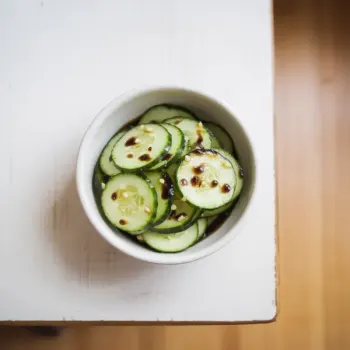
 40 minutes
40 minutesA delightful treat with a hidden burst of sugary goodness in every bite.


cups
cups
Lukewarm Water
cups
Dark Palm Sugar, chopped into small chips the size of a half-peanut
cups
1. Mix Flours and Water
Combine the sticky rice flour and rice flour in a mixing bowl. Gradually add 0.5 cup of lukewarm water to the flours, stirring to mix until you have a smooth dough that isn’t too soft or sticky.
2. Adjust Dough Consistency
If the dough seems too dry, dribble in a bit more lukewarm water and stir again. Conversely, if the dough feels too soft, roll it in some extra rice flour to achieve a smooth, firm consistency.
3. Prepare Boiling Water
Fill a wide pot with about 4 inches of water and bring it to a boil.
4. Divide and Shape Dough
Cut the dough in half. Take one half and cut it into 16 equally-sized pieces. Moisten your hands slightly to prevent sticking, and flatten each piece of dough. Place 2-3 small chips of palm sugar in the center and gently fold the dough over the sugar, rolling it into a smooth ball.
5. Cook Filled Balls
Carefully drop the filled balls into the boiling water. They will sink initially but should rise and bob to the surface after about 5 minutes, becoming translucent and indicating they are properly cooked.
6. Shape and Cook Unfilled Balls
For the smaller, unfilled balls, shape the remaining dough into small balls and follow the same boiling process. These will cook faster, taking about 2-3 minutes to rise and float, indicating they are done.
7. Drizzle with Sugar Syrup
To prevent sticking, drizzle the cooked smaller balls with a bit of sugar syrup, ensuring all surfaces are well-coated.
The dough for mochi is traditionally made by pounding glutinous rice, but a quick version can be made using glutinous rice flour and water. Mochi can be filled with sweet fillings like sweetened red bean paste or ice cream, or can be used in savory dishes like ozoni soup.
This is a similar concept but often includes fillings like black sesame paste, peanut paste, or red bean paste. The balls are served in a light syrup or with fermented rice wine.
Add the zest of a lime or orange to your palm sugar filling. The citrus notes will provide a fresh, tangy contrast to the sweetness of the sugar, which can really brighten up the flavor profile.
A variation on mochi, daifuku includes a filling of sweetened red bean paste or strawberries wrapped in a soft rice dough.
After cooking, roll the rice balls in toasted, shredded coconut. This adds a delightful crunch and nuttiness that complements the gooey interior of the sweets.
Use the best quality palm sugar and fresh rice flour for unparalleled depth of flavor and to avoid off tastes affecting the texture.
Sift rice flour for smoothness, ensure proper thickness for setting, and adjust consistency as necessary for perfect texture.
Constant stirring with a sturdy spoon or spatula is essential to prevent lumps and achieve a smooth, transparent texture.
Maintain a gentle simmer to cook the rice flour without caramelizing the sugar, preserving the dessert's transparency and flavor.
Prepare greased or lined molds to pour the hot mixture into and work quickly to shape before setting begins.




Comments (0)